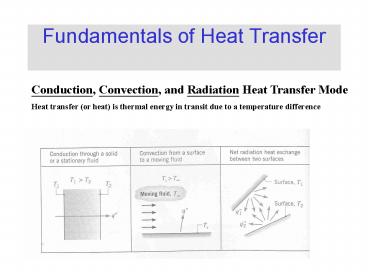Fundamentals of Heat Transfer - PowerPoint PPT Presentation
1 / 30
Title:
Fundamentals of Heat Transfer
Description:
Fundamentals of Heat Transfer Conduction, Convection, and Radiation Heat Transfer Mode Heat transfer (or heat) is thermal energy in transit due to a temperature ... – PowerPoint PPT presentation
Number of Views:317
Avg rating:3.0/5.0
Title: Fundamentals of Heat Transfer
1
Fundamentals of Heat Transfer
Conduction, Convection, and Radiation Heat
Transfer Mode Heat transfer (or heat) is thermal
energy in transit due to a temperature difference
2
Conduction Heat Transfer
- First mechanism - molecular interaction (e.g.
gas) - Greater motion of molecule at higher energy level
(temperature) imparts energy to adjacent
molecules at lower energy levels - Second mechanism by free electrons (e.g. solid)
3
Thermal Conductivity
- Physical origins and rate equation
- Association of conduction heat transfer with
diffusion energy due to molecular activities.
4
Thermal Conductivity of Gas
- Estimation of the thermal conductivity of gas
- Derived from the gas kinetic theory
- (1) Considering the summation of the energy flux
associated with the molecules crossing the
control surface - (2) The number of molecules involved is related
to average random molecular velocity. - (3) k Boltzmann constant, d molecular diameter,
m mass per molecule.
Unit W/(m-K)
5
Thermal Conductivity of Solid
- Estimation of the thermal conductivity of solid
- (1) Derived from the Wiedemann, Franz, Lorenz
Equation (1872). - (2) The free electron mechanism of heat
conduction is directly analogous to the mechanism
of electric conduction. - ke electrical conductivity unit 1/(W-m), T
absolute temperature (unit K), L Lorenz
number.
6
(No Transcript)
7
(No Transcript)
8
The proportionality constant k is a transport
property known as the thermal conductivity (W/mK)
and is a characteristic of the wall material.
9
(No Transcript)
10
(No Transcript)
11
r
12
Finally for the same amount of heat flow the
fluxes based on The inner and out surface areas
differ by approximately 42.
13
(No Transcript)
14
(No Transcript)
15
Convection Heat transfer due to convection
involves the energy exchange between a surface
and an adjacent fluid Forced Convection When a
fluid is made to flow past a solid surface by an
external agent such as a fan or
pump Free/Natural Convection Warmer (or cooler)
fluid next to the Solid boundary cause
circulation because of the density variation
Resulting from the temperature variation
throughout a region of the fluid. Newtons
Law of Cooling q/A hDT q rate of convective
heat transfer (W) A area normal to direction
of heat transfer h convective heat transfer
coefficient, DT temperature Difference between
the surface and the fluid.
16
- Convective Heat Transfer Processes Ref ID
(Figure 1.5 p7) - Forced Convection, (b) Free/Natural Convection,
- (c) Boiling, and (d) Condensation.
17
Boundary layer development in convection heat
transferRef. ID (P. 6 Fig. 1.4)
18
Radiant Heat Transfer (1) No medium is required
for its propagation. (2) Energy transfer by
radiation is maximum when the two
Surfaces are separated by vacuum. (3) Radiation
heat transfer rate equation is given by the
Stefan-Boltzmann law of thermal radiation
q rate of radiant energy emission (W)
A area of emitting surface (m2) T
absolute temperature s Stefan- Boltzmann
Constant 5.676 x 10-8 W/m2-K4
19
- Radiation Exchange. Ref ID (Figure 1.6 P. 9)
- At surface and (b) between a surface and large
surroundings.
20
(No Transcript)
21
The three modes of heat transfer have been
considered separated. In real world, different
modes of heat transfer are coupled. Consider
the case below for steady state conduction
through a plane wall with its surfaces held at
constant temperature T1 and T2.
T1
T2
x
L
22
(No Transcript)
23
(No Transcript)
24
(No Transcript)
25
(No Transcript)
26
(No Transcript)
27
10.27 2.673.82
k value for 85 Magnesia WWWR Page 676 With
interpolation
28
(No Transcript)
29
(No Transcript)
30
(No Transcript)































